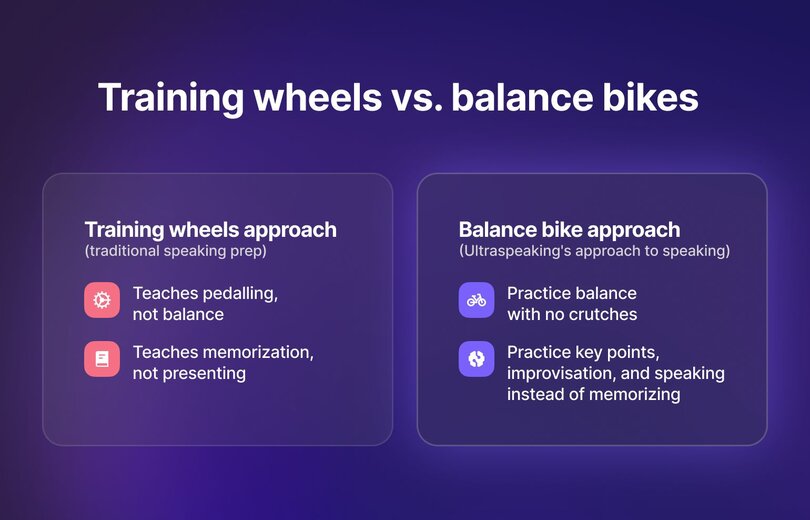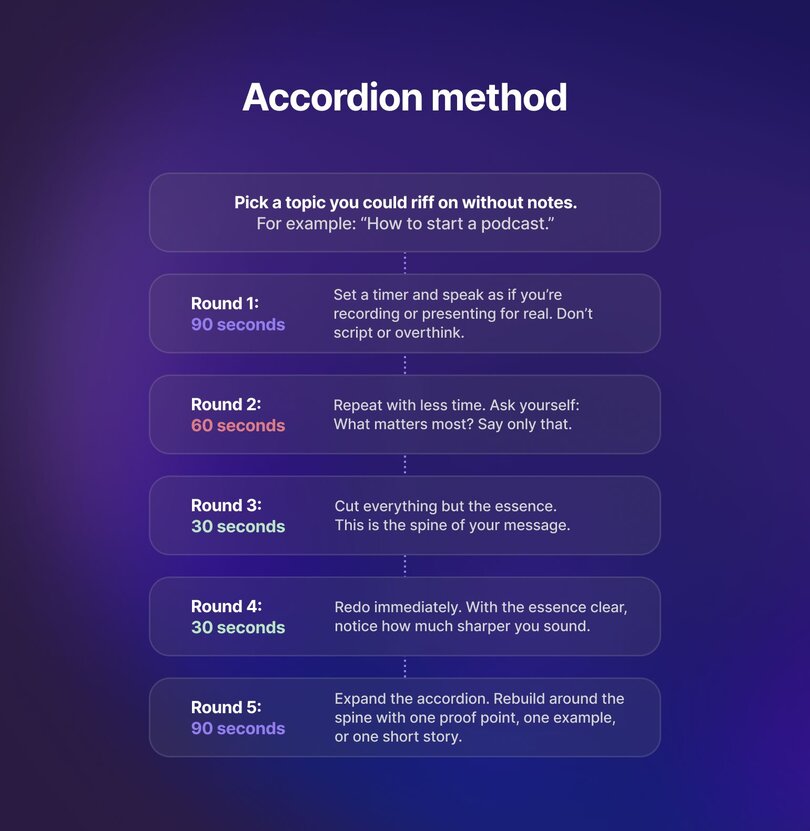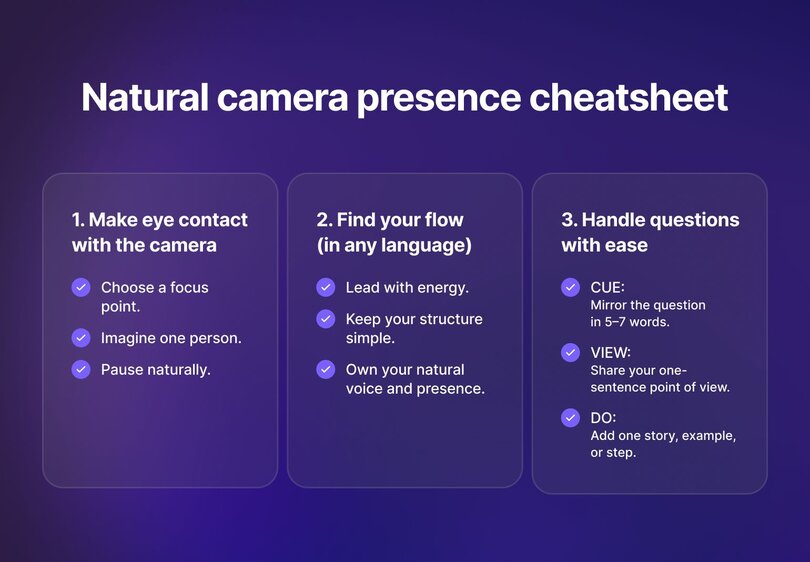The on-camera confidence playbook for creators
Ever freeze up the moment the camera light turns red? 🥶
You’ve scripted every word and practiced out loud. But when it’s time to speak for real, your delivery feels awkward because you keep trying to reach the right next word from your script. And the harder you chase perfection, the less confident you actually feel.
That’s the trap of traditional speaking prep. Writing and memorizing can make you feel ready on paper. But under pressure, one slip or forgotten line and the whole thing unravels.
If you’ve ever wondered about how to be confident on camera, without hours of prep or the pressure of getting every word right, this guide is for you.
At Circle’s Creator Path Summit, Ultraspeaking co-founders Tristan de Montebello and Michael Gendler shared a better way. Their method helps you enjoy speaking, think on your feet, and sound like yourself, even when the stakes are high.
In this article, we’ll break down their approach to building authentic presence on cue. Whether you’re hosting a live session, recording a podcast, or leading a course, you’ll walk away with a practical framework for becoming a more adaptable and confident speaker.
Why “perfect prep” makes you stiff (and what to do instead)
Think back to learning how to ride a bike. If you’re a millennial or older, that likely meant training wheels. Two little wheels bolted on the back to keep you upright. They felt safe because you couldn’t tip over.
But training wheels don’t actually teach balance. The moment they come off, you’re back at square one, wobbly and bracing for a fall.
That’s why many kids now learn to ride on balance bikes instead. A balance bike is small and pedal-less, so it forces them to practice the fundamental skill of balancing without the crutch. The result? They glide into riding almost effortlessly.
Traditional speaking prep works the same way. Scripts, memorization, and choreographed gestures are like training wheels. They feel safe, but as Tristan explains, “Memorization is like a taut chain. Take one link out, and it’s gone.” That’s why even small slips can trigger blanking and anxiety.
Ultraspeaking’s “balance bike” approach to building public speaking confidence flips this:
- Instead of scripting, you practice speaking your ideas aloud in real-life settings.
- Instead of memorizing, you internalize your key points so you can expand or contract them on the fly.
- Instead of choreographing, you learn how to improvise and embrace imperfections.
As Michael puts it, “It’s the difference between, ‘I hope I sound smart,’ and, ‘I hope this is valuable.’”

💡 Your new public speaking mantra:
“Slow is smooth. Smooth is fast.”
If you find yourself stumbling over your words, slow down the pace so your ideas can catch up. Fluency and confidence will follow.
How to be confident on camera with the Accordion Method
One of the biggest challenges in speaking on camera is knowing what to keep and what to cut. You may start strong, but quickly drift into rambling. Or you may over-edit and sound robotic. That’s where the Accordion Method comes in.
Michael explains: “What we’re doing is compressing time using time constraints, and that is forcing clarity. We’re getting rid of all the noise as we go.”
Just like the instrument, the method works by contracting and expanding. Here’s how to try it:
- Pick a topic you could riff on without notes. For example: “How to start a podcast.”
- Round 1: 90 seconds. Set a timer and speak as if you’re recording or presenting for real. Don’t script or overthink.
- Round 2: 60 seconds. Repeat with less time. Ask yourself: What matters most? Say only that.
- Round 3: 30 seconds. Cut everything but the essence. This is the spine of your message.
- Round 4: 30 seconds again. Redo immediately. With the essence clear, notice how much sharper you sound.
- Round 5: 90 seconds. Expand the accordion. Rebuild around the spine with one proof point, one example, or one short story.

As Circle’s Brand Partnerships Lead, Alexis, reflected on after trying it: “The first 90 seconds did feel low stakes because it felt like a brainstorm. And then we’re condensing down, shaping and refining the content. And then when you expand, you have more context and more of a direction on what you’re trying to say.”
💡 Run accordion reps as a community engagement drill.
- Host a weekly live event with 5 to 8 members in your Circle space.
- Rotate hot seats so each person runs the 90-60-30-30-90 stack.
- After each round, peers drop three sticky words they heard.
- Use these words as practice cues. For instance, if your group captures “clarity, story, honesty,” aim to highlight those three elements in your next riff.
Over time, these anchors sharpen your delivery and make your message stick.
Polish like a pro (without scripts) in 2 simple steps
You don’t need a teleprompter to sound polished. After you use the Accordion Method to clarify your ideas, the next step is giving them just enough structure so they land every time.
Step 1: Run the speak-to-prepare flow
Got an idea in mind? Bring it to life quickly and naturally with this 15-minute flow:
- 3 minutes: Brainstorm out loud. Record a voice memo.
- 2 minutes: Pull your 5-point plan from what you just said (see step 2)
- 5 minutes: Run the Accordion to refine clarity.
- 5 minutes: Watch back at 1.25× speed. Jot only what to cut or sharpen.
Step 2: Build a 5-point plan
This is the skeleton for your talk. Here’s how we could turn Alexis’ riff from the session on starting a podcast into an outline:
| Focus | Description | Example |
|---|---|---|
| Hook | Curiosity or tension. | “Most podcasts don’t make it past 10 episodes.” |
| Promise | What they’ll walk away with. | “How to design a show you’re excited to create and that delivers value to listeners.” |
| 3 Beats | A–B–C points, each with a micro-example. | (A) Know your why and the value you bring. (B) Build a show you’re energized to record every week. (C) Create something listeners can’t wait to share. |
| Anchor | Tie your message back to the bigger idea or value. | “Podcasting works when you connect energy with listener value.” |
| Close | One action, one sentence. | “Write down your why and three listener benefits before you hit record.” |
With just 15 minutes, you’ll move from a vague idea to a repeatable talk. The process leaves you with a clear outline you can trust, so when the camera turns on, you can focus on connecting instead of remembering lines.
💡 Try the sticky note test. If your 5-point plan doesn’t fit on one sticky note, it’s too complicated. Refine until you can carry the whole talk in your pocket.
3 subtle skills to master for natural camera presence
The camera turns on, and suddenly your eyes dart, your hands fidget, and your words tumble out too fast.
Even with clear ideas from the Accordion and a simple 5-point plan, nerves can still trip you up. That’s when mechanics matter.
The good news? You don’t need big stage gestures or a perfect broadcast voice. A big part of learning how to be confident on camera is:
- Where you look when you speak.
- The way you use your energy, cadence, and gestures.
- How you respond when someone throws you a question.
Practice these, and you’ll stop worrying about the lens and start coming across like you’re having a real conversation.

Make eye contact with the camera lens
If looking into a camera lens feels awkward, you’re not alone. Most people start out glancing away or dropping their eyes whenever they need to think. That’s normal. But it gets easier with practice.
Tristan had the same struggle. “When I started [public speaking training], I couldn’t look at anybody. Anytime I had to think, I had to look down. But little by little, I got more comfortable and eventually I could look someone in the eye while I was speaking to them and start connecting.”
On camera, the same principle applies. You don’t have to stare down the lens nonstop. Instead, try these techniques:
- Choose a focus point. Place a small dot or sticker beside the lens and treat it like a pupil.
- Imagine one person. Speak to a single friend or client, not a faceless audience.
- Pause naturally. When you need to think, glance away, breathe, then return. It reads as human, not anxious.
💡 Make it personal. Write the name of a friend or client on a sticky note and place it near your lens. You’ll find it easier to relax and connect when you know exactly who you’re talking to.
Find your flow in any language
If English isn’t your first language, you might feel pressure to search for the “perfect” words. That hesitation can make speaking on camera feel stressful. Michael reframes it: “Speaking is a flow-oriented process. We speak better when we’re not actively thinking about it.”
Try these strategies to find your flow:
- Lead with energy. Speak a little louder, smile, and use natural gestures to emphasize what you’re saying.
- Keep your structure simple. Use your 5-point plan or Accordion spine. Structure carries the message even if every word isn’t perfect.
- Own your natural voice and presence. Your rhythm, accent, and body language make you memorable and authentic.
Most people care more about your ideas than your vocabulary. Focus on clarity and a steady pace, and you’ll project confidence on camera no matter what language you’re speaking in.
💡 Run it twice. Do your first take in your native language, then repeat it in English using the same outline. You’ll feel freer, and your delivery will sound more natural.
Handle questions with ease
Live Q&A and interviews test your on-camera presence more than anything else. You can’t prepare every answer, but you can decide how you respond in the moment.
Tristan explains, “If you try to be quick on your feet by trying to speak faster, you’re going to have the opposite effect.”
Instead, when the spotlight’s on you, use this framework to stay steady:
- CUE: Mirror the question in 5–7 words.
- VIEW: Share your one-sentence point of view.
- DO: Add one story, example, or step.
If your mind goes blank, try: “Let me take a beat to give you a useful answer.” That short pause gives you space to think and makes your response sound more deliberate.
💡 Breathe before you answer. A single, deep inhale gives you a moment to think, helps you stay calm, and makes your response sound more grounded.
Signals that you connected
As a creator, it’s easy to obsess over views and subscriber counts. But those numbers don’t tell you if your speaking on camera is landing the way you want it to. The real question is: are people connecting with you?
Primary signals
These are the clearest indicators that your content is resonating:
- Replies or DMs from viewers. When someone takes the extra step to reach out, it shows you’ve sparked a personal response.
- Repeat watch rate. If viewers come back to your videos or sessions, it means your delivery and your content felt authentic and valuable enough to revisit.
- Comment quality. Look for depth over volume. Comments like “This felt like you” or “I felt like you were talking to me” show that your on-camera confidence is translating into trust.
Secondary signals
These metrics don’t always prove connection on their own, but they do show whether people are sticking with your content:
- Completion rate. Higher percentages suggest your pacing and delivery kept attention.
- Saves and shares. When someone saves your video or passes it on, it signals usefulness.
- Session time. Longer watch times point to momentum across multiple videos or modules.
Tertiary signals
Views and subscriber counts can help gauge reach, but they won’t tell you if your message is landing.
The north star metric is simple: connection over count. Track the signals of trust and resonance, and you’ll know your camera presence is working.
💡 Track one connection metric each week. Whether it’s a DM, a repeat view, or a thoughtful comment, these are the true markers of content creator momentum.
Turn on-camera confidence into community impact
Speaking on camera will always feel a little vulnerable. But when you learn to steady your breath, shape your message, and practice in real conditions, you create space for connection. And that connection is what powers communities. It turns a single viewer into an event attendee, and an attendee into a loyal member.
Here are the key lessons to carry with you:
- Prepare by speaking. Build your confidence through live practice (not scripts) with the Accordion Method.
- Lead with authenticity. As Michael said, “It’s the difference between ‘I hope I sound smart’ and ‘I hope this is valuable.’”
- Practice in low-stakes settings. Repetition makes you more adaptable when the moment matters, whether it’s a webinar, a cohort kickoff, or a live Q&A.
- Pause to find clarity. Tristan reminds us: “Slow is smooth, and smooth is fast.” Breathing gives your ideas weight and gives your audience space to absorb them.
On-camera skills are more than presentation techniques. They’re community-building tools for people who are aligned with your message. Every message you deliver shapes how people experience your brand and whether they choose to engage more deeply.
Each rep, each pause, each authentic moment builds trust. And trust fuels community.
Ready to put these skills into practice? Build and host your workshops, cohorts, and community in one place — with events, courses, and engagement tools under your brand. Try Circle free for 14 days.